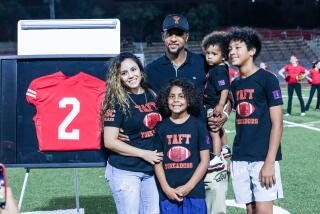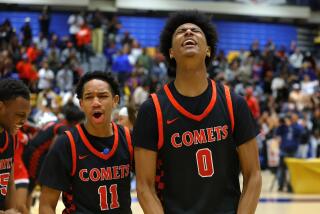Multisport Standout
- Share via
High school sports serve as a rite of passage for the athletes who play them, the student, friends and families that gather to watch them and the sportswriters who cut their professional teeth covering them.
High school football games in Los Angeles date to 1896, but it wasn’t until 1934 that the Los Angeles City Section was born.
The Southern Section was established in 1912 and held its first athletic competition in 1913.
This story is not an attempt to document the achievements of every outstanding athlete, coach and team that made a mark, for there are far too many to chronicle here.
Rather, it is a history lesson of sorts told by current and former Times staff writers who have written about Southland prep athletes. Most of the writers graduated from Los Angeles-area high schools. And while many have gone on to cover college and professional sports as beat writers or columnists, all maintain indelible images of the prep athletes they watched, covered and, in some instances, competed with and against on the playing field.
*
In the spring of 1958, at 18, I drove my 1952 Morris Minor from Corona del Mar to Long Beach City College to see a CIF basketball semifinal between Santa Maria, led by John Rudometkin, and Colton, led by Ken Hubbs.
Rudometkin was amazing. He scored 39 points before fouling out.
But I’ve never forgotten the game Hubbs played that night. He is the greatest high school athlete I ever saw.
Hubbs was a 6-foot-2 guard who could shoot from long range, run the break like a sprinter, rebound, drive the lane and pass and shoot with either hand.
I saw him dunk with two hands during warmups. Years later, I learned from his brother he could put his forearm on the rim.
Hubbs scored 23 points that night--five in the last 23 seconds. He made a half-court shot at the halftime buzzer, then a 20-footer at the regulation buzzer to send the game into overtime. Colton won, 63-59.
In his junior and senior years, Hubbs was All-CIF in football (quarterback), basketball and baseball (pitcher-infielder). He once high-jumped six feet in his baseball uniform.
John Wooden wanted him. Notre Dame and every other football power wanted him. But so did major league baseball, and he signed with the Chicago Cubs in the summer of 1959 for $50,000.
He was the Cubs’ starting second baseman in 1964 when, at 22, he died in the crash of his small plane near Provo, Utah.
At the funeral, the auto procession to his burial was two miles long.
More to Read
Go beyond the scoreboard
Get the latest on L.A.'s teams in the daily Sports Report newsletter.
You may occasionally receive promotional content from the Los Angeles Times.










